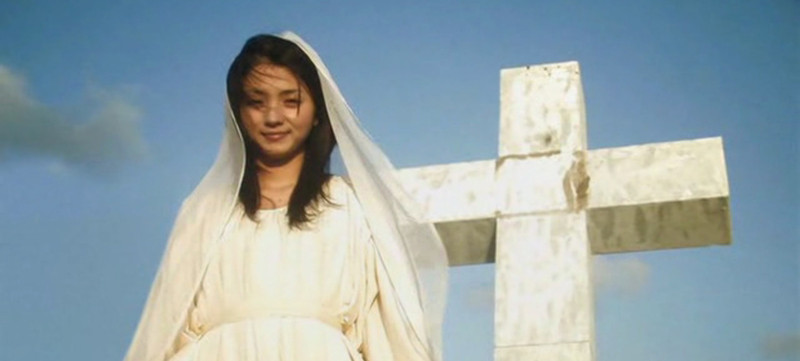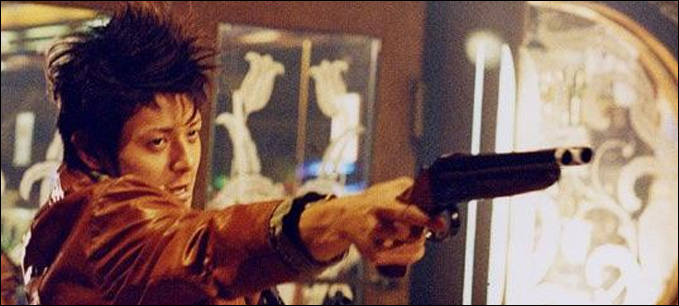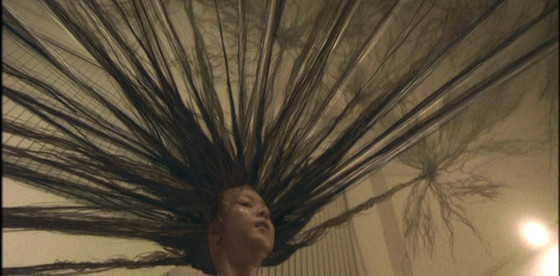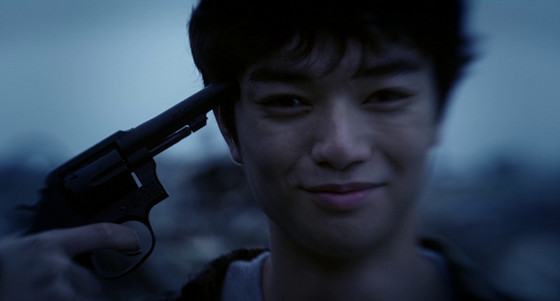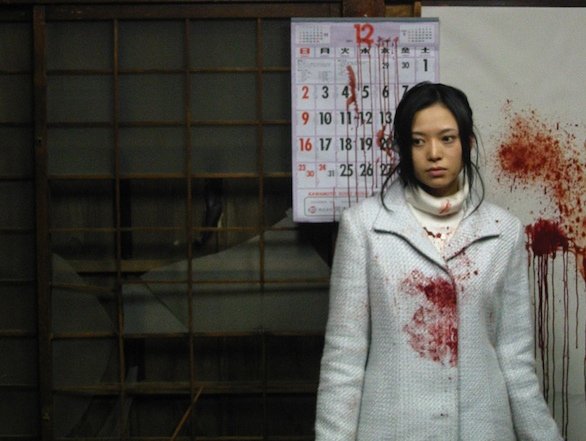Sion Sono, who has directed 46 films since 1984, is one of the most prolific filmmakers of Japan, excelling in everything grotesque, abnormally erotic and exceedingly violent that can be found in a movie. He is considered one of the artists who finally modernized the preterit genre of J-Horror, transforming it into something closer to the “ero guro” style that includes, besides terror, eroticism, sexual corruption and both physical and spiritual decadence.
Sono, who is also an accomplished poet, started his career by winning a fellowship from the PIA Awards, a competition aiming to finance, produce and promote films by new directors. Having secured funding from the festival, he went on to write, direct and star in “Bicycle Sighs”. That film played in more than 30 venues in Europe and Asia, establishing him, from the beginning of his career, as a global presence.
He is also presently renowned in the United States, a fact that was stressed when the Museum of Arts and Design in New York City presented his work, in the 2011 exhibition titled “Sion Sono: The New Poet”.
There are a number of themes in his movies, mostly having to do with his actors. Among his most distinct are the recurring personnel, including Denden, Yoshihiro Nishimuta (6 titles each) and Megumi Kagurazaka (5 titles), who is also his spouse. He is also known for the choosing widely unknown actors as main leads, and the “revival” of inactive actors through his works, from a filmmaker who always took care of his collaborators.
In his career that has spanned for more than three decades, Sono has garnered awards from all over the world and is considered one of the prominent cult filmmakers of his generation. Here is a list of the movies that led him to that acclaim.
10. Hazard (2005)
Shot in 2002 in a true “guerilla” style, mostly with a handheld camera, “Hazard” is one of the hidden treasures in Sono’s filmography, until its release in Japan in 2006. It stars Joe Odagiri, who was still rising to Japanese stardom at the time.
Shin is a university student, frustrated and bored with contemporary life in Japan. When he discovers a book detailing the plethora of hazards in New York, he instantly decides to travel there. Upon his arrival in the city via the subway, he is mugged, and left penniless and lost. Sometime later, when he tries to steal something to eat from a liquor store, two Japanese persons confront him, eventually putting him under their protection.
Sono shoots a film about friendship, crime, violence and literature, providing a clear message about the disillusion between what is boring and what is exciting. Although purely fictional, the use of the handheld camera gives “Hazard” a documentary-like feel, while presenting a foreigner’s view of life in the streets of New York.
9. Exte: Hair Extensions (2007)
Sion Sono had decided to return to the J-Horror genre and consequently to the mainstream of Japanese cinema, so he recruited a number of the foremost prominent members of the genre. Misaki Adachi, who co-wrote the script with him and served as assistant director, had also worked in latter capacities in “Juon 1.2” and “Dark Water”; Chiaki Kuriyama had international fame from her roles in “Kill Bill” and “Battle Royale”; Ren Osugi had worked on a number of the most distinguished horror films, such as “Charisma”, “Cure” and “Uzumaki”. “Exte”, which is a slang term for hair extensions, is probably his most conventional film.
Two port inspectors uncover a dead human body inside a container filled with extensions. The forensics discover that most of the girl’s organs are missing, which infers that she was a victim of organ trafficking. Sometime after the examination, Yamazaki, the half crazed night watcher of the morgue who also has trichophilia, steals the body and takes it with him to his house, due to the exquisite beauty of the hair on it. At home he discovers with great pleasure that the hair of the deceased continues to grow at a rapid rate.
Yuko is a young hairdresser trainee who has been tortured for years by her irresponsible older sister, Kiyomi. In one utterly insensible act, the latter abandons her young daughter in Yuko’s care and leaves. Having to work long hours, Yuko is obliged to leave the girl alone in her house. One day, Kiyomi, in a panic, leaves the house to search for her aunt, but instead she gets lost. Yamazaki discovers the lost girl and brings her to the hairdresser’s, where he is deeply impressed with Yuko’s hair.
Sono uses one of his regular, utterly illogical ideas to present a social comment of the contemporary Japanese tendency to submit to any trend. Apart from that, his greatest accomplishment is maintaining a level of seriousness, in a concept that could very easily fall over the bridge. “Exte” is quite a terrifying film, particularly in the more claustrophobic scenes. It has excellent performances by Chiaki Kuriyama, with her utterly terrifying facade and Ren Ohsugi, who actually plays a horror clown with great success.
8. Himizu (2011)
Sono was deeply touched by the nuclear incident in Fukushima, an influence that materialized radically in his themes and style with two movies, “Land of Hope” and “Himizu”. Based on the homonymous manga by Minoru Furuya, Sono had already adapted the script when the occurrence took place, thus allowing him to change the scenario to incorporate his new ideas.
Yuichi is an adolescent who made a bet with himself to try to be a normal person, despite the crazy world he lives in. Unfortunately, he seems to lose the bet, chiefly because his parents, a drunk and a prostitute, tend to make his life a living hell. After experiencing a life altering incident he transforms into a devious individual and his fate of becoming either suicidal or a murderer is closer than ever. The only person who seems determined to prevent him is Keiko, a girl from an equally decayed family, who is in love with him.
Accompanying them are many other homeless individuals, whose lives are in ruins due to the earthquake, the tsunami and the radiation brought on by the incident on March 11, 2011.
Sono places his protagonists in a dystopian, post-quake Japan, while using Yuichi to symbolize the perverse reality of his country in the modern age. This makes a very pointed remark about the previous generation; according to Yuichi, they are to blame for the current situation.
Sono said he altered the script to show that despite the size of the catastrophe, the people of Japan must retain hope and not back down, and they must strive to change the country as well as themselves.
Alongside the accomplished performances of his leads, “Himizu” includes a truly harrowing finale, one of the best ever seen in a Sono movie.
“Himizu” was screened at the Venice Film Festival, where it was bestowed the Marcello Mastroianni Award for the two protagonists, Shota Sometani as Yuichi and Fumi Nikaido as Keiko.
7. Noriko’s Dinner Table (2005)
Though screened after “Suicide Club”, “Noriko’s Dinner Table” is a prequel of sorts; an endeavor by Sono to clarify the incidents of the former film, thus taking place before, during and after its timeline.
Noriko is a 17-year old girl who feels unhappy with her family, until she finds a website frequented by girls her age, from all over Japan, experiencing the same sentiment. For the first time in her life, Noriko feels that there are people who can understand and sympathize with her, so she decides to leave her home for Tokyo. There, Noriko and Kumiko, another girl from the website, become members of a corporation that specializes in offering the illusion of family, to those who are not experiencing it.
Sion Sono deals with the concepts of friendship and family in contemporary Japan by focusing on individuals, chiefly the relationship between the two aforementioned girls, the story of Noriko’s sister, Yuka, and the growing distress of their father, Tetsuzo, who experiences the demise of his family through the disappearance of his daughters.
Although beautifully directing, this film suffers from an overly complicated script as well as the considerable length (159 minutes), both making clear its low budget. The plot was intended to wrap up in a third installment that never came to be, due to financial reasons. With that said, “Noriko’s Dinner Table” appears incomplete, although that did not bother the festivals around the world that screened and awarded it.
6. Why Don’t You Play in Hell? (2013)
This particular movie marked Sion Sono’s return to the themes and forms that made him what he is, after the release of “Himizu” and “Land of Hope”. The film premiered at the Venice Film Festival, where a 10-minute standing ovation took place upon its conclusion.
Many parallel stories run simultaneously in “Why Don’t You Play in Hell” and it is quite an accomplishment that Sono does not lose track of them.
Ten years ago, Ikegami, a Yakuza boss, staged a hit against his rival Muto that ended in a bloodbath caused by Muto’s wife. The incident made the papers, thus terminating their daughter Michiko’s acting career. Now, Muto wants to make a movie with his daughter in the lead, to celebrate his wife’s release.
However, the girl has fled the shootings to search for her ex-boyfriend, dragging Koji, an irrelevant bystander, along with her. At the same time, Ikegami, the sole survivor of the massacre, is preparing to take his revenge. Meanwhile, The Fuck Bombers, an amateur film crew, are trying to fulfill their dream of making the ultimate action epic.
Sion Sono combines Yakuza wars, romance, the Japanese concept of the “idol” and cinema itself in a package of violence, humor and anime-like action.
The last part of the movie is truly epic, simple in its presentation and at the same time complex in its conception. Sono aims to point out that the medium is changing and so are its rules, but the important thing is that it will not cease to exist, even if everybody in the industry must die.
Sono had an excellent cast in his hands, with Jun Kunimura (Muto), Fumi Nikaido (Michiko), Gen Hoshino (Koji) and Shinichi Tsutsumi (Ikegami), and he received their best in quite demanding roles.
